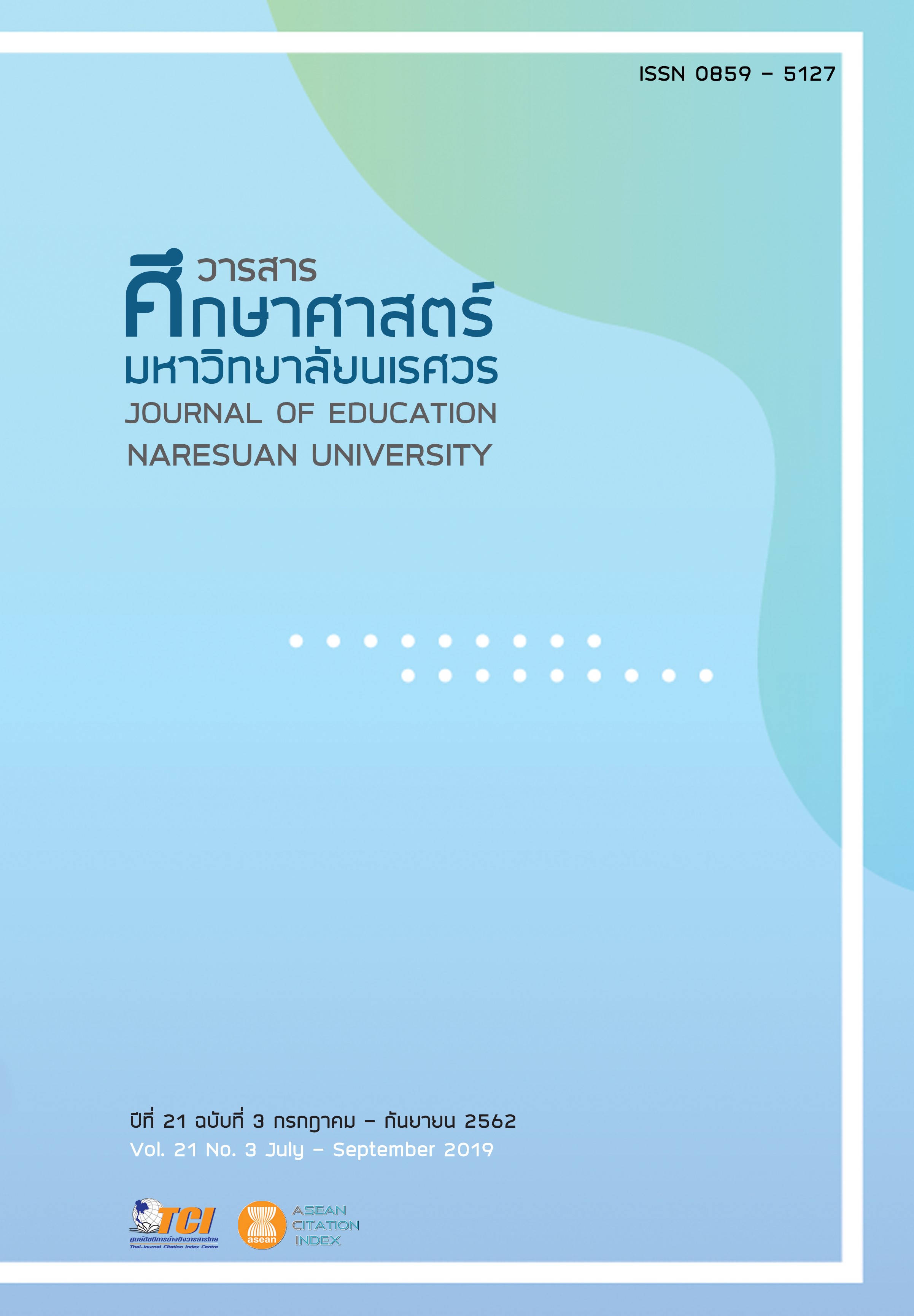การศึกษาความสามารถในการแก้ปัญหาและความสามารถในการสื่อสารทางคณิตศาสตร์ เรื่อง “บทประยุกต์” โดยใช้การแก้ปัญหาแบบฮิวริสติกส์ ของนักเรียนชั้นมัธยมศึกษาปีที่ 1 (THE STUDY OF MATHEMATICAL PROBLEM SOLVING AND COMMUNICATION ABILITIES ON APPLICATION BY USING HEURISTICS OF PROBLEM SOLVING OF MATHAYOMSUKSA ONE STUDENTS)
Main Article Content
Abstract
การวิจัยในครั้งนี้มีวัตถุประสงค์เพื่อศึกษาความสามารถในการแก้ปัญหาและความสามารถในการสื่อสารทางคณิตศาสตร์ เรื่อง บทประยุกต์ โดยใช้การแก้ปัญหาแบบฮิวริสติกส์ ของนักเรียนชั้นมัธยมศึกษาปีที่ 1 กลุ่มตัวอย่างที่ใช้ในการวิจัยครั้งนี้ คือ นักเรียนชั้นมัธยมศึกษาปีที่ 1 โรงเรียนสาธิตแห่งมหาวิทยาลัยเกษตรศาสตร์ ศูนย์วิจัยและพัฒนาการศึกษา กรุงเทพมหานคร ภาคเรียนที่ 2 ปีการศึกษา 2559 จำนวน 1 ห้องเรียน จำนวนนักเรียน 33 คน ซึ่งได้มาจากการสุ่มแบบกลุ่ม จากจำนวนห้องเรียนทั้งหมด 7 ห้องเรียน เครื่องมือที่ใช้ในการเก็บรวบรวมข้อมูลประกอบด้วยแผนการจัดการเรียนรู้ เรื่อง บทประยุกต์ โดยใช้การแก้ปัญหาแบบฮิวริสติกส์ จำนวน 9 แผน และแบบทดสอบวัดความสามารถในการแก้ปัญหาและความสามารถในการสื่อสารทางคณิตศาสตร์ เรื่อง บทประยุกต์ การวิเคราะห์ข้อมูลใช้การคำนวณค่าร้อยละ ค่าเฉลี่ยเลขคณิต ส่วนเบี่ยงเบนมาตรฐาน และสถิติทดสอบค่าที ผลการวิจัยพบว่า 1) นักเรียนมีความสามารถในการแก้ปัญหาทางคณิตศาสตร์ เรื่อง บทประยุกต์ ที่ได้รับการจัดกิจกรรมการเรียนรู้ โดยใช้การแก้ปัญหาแบบฮิวริสติกส์ สูงกว่าเกณฑ์ร้อยละ 60 อย่างมีนัยสำคัญทางสถิติที่ระดับ .05 และมีความสามารถในการแก้ปัญหาทางคณิตศาสตร์ เรื่อง บทประยุกต์ อยู่ในระดับดีมาก (ร้อยละ 80.13) และ 2) นักเรียนมีความสามารถในการสื่อสารทางคณิตศาสตร์ เรื่อง บทประยุกต์ ที่ได้รับการจัดกิจกรรมการเรียนรู้ โดยใช้การแก้ปัญหาแบบฮิวริสติกส์ สูงกว่าเกณฑ์ร้อยละ 60 อย่างมีนัยสำคัญทางสถิติที่ระดับ .05 และมีความสามารถในการสื่อสารทางคณิตศาสตร์ เรื่อง บทประยุกต์ อยู่ในระดับดี (ร้อยละ 70.19)
THE STUDY OF MATHEMATICAL PROBLEM SOLVING AND COMMUNICATION ABILITIES ON APPLICATION BY USING HEURISTICS OF PROBLEM SOLVING OF MATHAYOMSUKSA ONE STUDENTS
The purposes of this research were to study of mathematical problem solving and communication abilities on application by using heuristics of problem solving of Mathayomsuksa one students. The sample was 33 Mathayomsuksa one students of one classroom that was selected by cluster random sampling from 7 classroom at Kasetsart University Laboratory School Center for Educational Research and Development, Bangkok, in the second semester of the academic year 2016. The instruments in data collection consisted of 9 lesson plans on application by using heuristics of problem solving and mathematical problem solving and communication ability test on application. Percentage, arithmetic mean, standard deviation and t-test were used for analyzing data. The results of study revealed that 1) the students had mathematical problem solving ability on application after learning by using heuristics of problem solving was higher than 60% at the .05 level of significance and the mathematical problem solving ability on application was at the “very good” level (80.13%), and 2) the students had mathematical communication ability on application after learning by using heuristics of problem solving was higher than 60% at the .05 level of significance and the mathematical communication ability on application was at the “good” level (70.19%).
Article Details
The owner of the article does not copy or violate any of its copyright. If any copyright infringement occurs or prosecution, in any case, the Editorial Board is not involved in all the rights to the owner of the article to be performed.
References
2. Al-Fayez, M. Q., & Jubran, S. M. (2012). The impact of using the heuristic teaching method on Jordanian Mathematics Students. Journal of International Education Research, 8, 453-460.
3. Chuntra, C. (2012). Mathematics classroom assessment: From concepts to practice. Bangkok: R and N Print. [in Thai]
4. Eisenmann, P., Novotna, J., Pribyl, J., & Brehovsky, J. (2015). The development of a culture of problem solving with secondary students through heuristic strategies. Mathematics Education Research Journal, 27, 535-562.
5. Institute for the Promotion of Teaching Science and Technology. (2008). Mathematical skills and processes (2nd ed). Bangkok: S Charoen Printing. [in Thai]
6. Institute for the Promotion of Teaching Science and Technology. (2012). Mathematical measurement and evaluation. Bangkok: Se-education. [in Thai]
7. Institute for the Promotion of Teaching Science and Technology. (2016a). The result report of Programme for International Student Assessment 2015 (PISA 2015). Retrieved December 13, 2016, from https://pisathailand.ipst.ac.th [in Thai]
8. Institute for the Promotion of Teaching Science and Technology. (2016b). The research summary of Trends in International Mathematics and Science Study 2015 (TIMSS 2015). Retrieved December 13, 2016, from https://timssthailand.ipst.ac.th [in Thai]
9. Kankeerati, W. (2011). Mathematics learning management. Retrieved March 29, 2016, from
https://www.phichsinee.cmru.ac.th [in Thai]
10. Koichu, B., Berman, A., & Moore, M. (2007). Heuristic literacy development and its relation to mathematical achievements of middle school students. Instructional Science, 35, 99-139.
11. Krulik, S., & Rudnick, J. A. (1993). Reasoning and problem solving: A handbook for elementary school teachers [Mimmeograph]. Massachusetts: Allyn and Bacon.
12. Meesuk, R. (2012). The effects of learning emphasized heuristics thinking on mathematical achievement, problem solving and reasoning abilities on Polynomial Fractions of Mathayomsuksa three students (Master thesis). Bangkok: Srinakharinwirot University. [in Thai]
13. Ministry of Education. (2008a). Indicators and core contents of mathematics learning area according to the basic education core curriculum B.E. 2551 (A.D. 2008). Bangkok: Agricultural Cooperative Federation of Thailand. [in Thai]
14. Ministry of Education. (2008b). The basic education core curriculum B.E. 2551 (A.D. 2008). Retrieved July 5, 2016, from https://lowersecondarymath.ipst.ac.th/wp-content/ uploads/2015/PDF/Curriculum%202551.pdf [in Thai]
15. National Institute of Educational Testing Service. (2016). The result report of Ordinary National Educational Test (O-NET) in Mathayomsuksa 3 of academic year 2015. Retrieved April 2, 2016, from https://www.niets.or.th [in Thai]
16. Rattaraburterng, J. (2014). The study of mathematics learning achievement and word problem solving ability of Mathayomsuksa two students on “Quadratic Equation with One Variable” by using heuristics problem solving at Samutsakornburana School, Changwat Samut Sakhon (Master thesis). Bangkok: Kasetsart University. [in Thai]
17. Sodsangaroommgam, S. (2013). The study of mathematics learning achievement of mathayomsuksa two students on “Applications of Linear Equations with One Variable” by emphasizing heuristics thinking at Phrapathom Witthayalai School, Changwat Nakhon Pathom. Kasetsart Educational Review, 30(1), 103-110. [in Thai]
18. Supap, W. (2016). Mathematical word problems: students’ difficulties and recommended strategies. Journal of Education Naresuan University, 18(2), 264-275. [in Thai]
19. Thammasaranyakun, N., Dachakupt, P., & Kraimongkon, Y. (2012). Development of an instructional process using sternberg’s four step model and heuristics concept to enhance mathematical reasoning and problem-solving abilities of sixth grade students. Journal of Education Naresuan University, 14(1), 77-95. [in Thai]
20. Thipkong, S. (2002). Theories and methods of teaching mathematics [Mimmeograph]. Bangkok:
Department of Educational, Faculty of Educational, Kasetsart University. [in Thai]
21. Ugsonkid, S. (2012). Mathematical problem solving and problem posing. Bangkok: Vista Inter Print. [in Thai]


